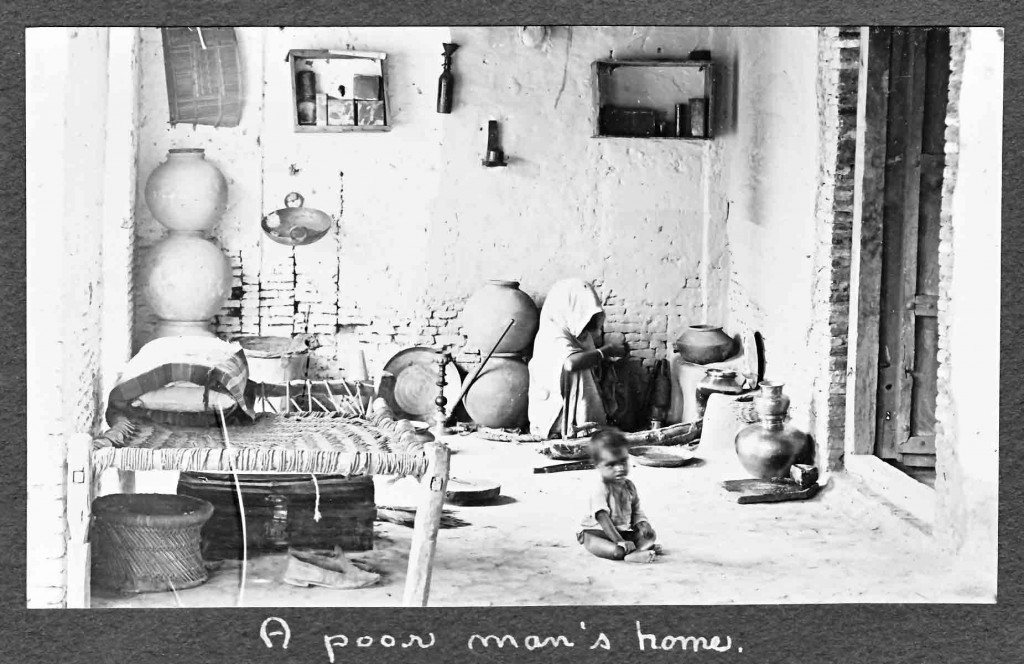Monday, March 11, 1929
Well, I finally got the Omelette Special and it’s the best thing I’ve tasted in months. About 8 by 5 inches and two high, all crisp in the outer frills and with jelly inside. Made sort of like a waffle. I got to the train twenty minutes early and it was already packed. As today Ramadan is over and as it is the Moslem Xmas, everybody was present. I asked a couple of men to put their boxes on the floor, though, and thus got a seat. Both proved more than nice to me; one speaking a few words of English tried to teach me some Arabic. I proudly wrote my name for him in Arabic and darned if he didn’t pronounce it Ditla Leoybic. I cheerfully lied, that was it exactly. The car had seats for 112, but very nearly 160 were in it all the way to Luxor. Sometimes it got so crowded you couldn’t even move a foot for two hours at a time. At others we had to drape them over boxes and baskets.
A corporal in the army spoke English pretty well and was also extremely nice to me, even to insisting on getting me coffee when a man came through the car selling it. All about me wanted to share their dinner of bread and perhaps an orange or hard-boiled egg. The car was filthy with dust and dirt brought in by the passengers. Boxes, bags, etc. piled high all down the aisle so you could barely get through by much climbing. I was near the door though. About half pulled off their sandals or shoes and curled up or squatted and tried to sleep. They lay all over the aisle and even on the floor under the seats. After midnight it became pretty chilly. People, one after the other, would climb over everybody and go out the door, leaving it stand open. This sure got my friends down and especially a big sleepy-looking very black job all wrapped up in a black cape and scarf about the head. He was right against the door and was always awakened, just as he got to sleep, by the door opening or being left open. The two ugliest women in Egypt sat across the aisle from me. Both smoked (the first I have seen here) and obviously for effect. In fact, one lit half a dozen or more fags, took a few puffs, then passed it to her unfortunate and nice-looking husband to finish. I dozed off a few times but was always conscious of what was going on about me.
At six the eastern sky began to grow pale slowly. Then the gray gave way to a narrow stripe of pale orange sky along the horizon. This slowly widened and grew upwards, forming four distinct shades of oranges in separate bands, the lower more nearly approaching red. But the most extraordinary sight was the color of the sky above this—a green, which very slowly faded to gray higher in the sky. This weird green lasted only a few minutes. The sun did not appear for a long time after the whole east was a light orange. We had crossed the Nile and were on the east side not far from the river. A thin veil of mist hung over the low flat country. Sometimes we could see huge high cliffs of sandstone or of limestone on one side or the other or perhaps both. The striations showed clearly even at several miles and they gave the early morning scene a charmed atmosphere.
Mud villages under the palms rushed by, People on their way to the fields or towns rode along paths on donkeys or camels, or walked. Shepherds were driving their goats to pasture; oxen were pulling old wooden plows through the fields; a camel or ox slowly turned a large wooden waterwheel by going around in a ceaseless circle, or perhaps a barefooted native was dipping it up from one level to the other, for the little irrigation ditches cut the fields every few feet. This is a laborious task—a bucket at the end of a long pole and a big rock weight at the other, held up in the center by another pole stuck in the ground.
Finally arrived in Luxor at 8:30 AM. The town is a fair-sized one, practically all native. A few hotels take care of the multitude of tourists, mostly Americans and English but lots of French, Germans, and even Egyptians. The pretty Winter Palace is on the Nile and has a fine view.
There is plenty of dirt in Luxor, lots of beggars, and plenty of dragomen and mule owners, etc. All the children beg for baksheesh from three years old up. It is a habit with them. When you pass them they say baksheesh every time, perhaps never looking around to see if you “loosen up.” The boys and men are as bad or worse. Four out of five of these guards of the monuments, donkey drivers, dragomen, etc. will ask for a cigarette. If you haven’t one, they ask for money to get it with. Perhaps they will fall in and tag you with the street for a block or so and expect a tip for telling you something about a temple or pointing out an object to you. This afternoon a boy driving a camel asked me for a cigarette so I spoke back in French to get rid of him. It did, but as I walked away, he said “Go on away” in English. I turned around and asked him what he said. It was hard to keep from laughing for he was so frightened he nearly knocked his donkey over in trying to get away, at the same time telling me he was speaking to a boy about 200 feet up the road coming toward us.
 Flies and fleas are the curse of Luxor. At the present time the streets and country are filled with swarms of flies which insist upon flying in your eyes, nose, mouth, and ears. I have talked to natives who not only had flies in their eyes and on their face, but crawling on their lips and teeth! And babies and young children are literally covered with the pests, and seemingly take little notice of them. The Europeans and a few natives carry bamboo things that resemble a small broom, only more bushy, or else a more elaborate one of horse-hairs with ivory or leather handles. These are an absolute necessity for any degree of comfort at all. Frank lent me his nice leather one and I never go out without it. It is not an occasional fly you shoo away but a continuous, persistent horde that forever buzzes around your head and all settle if you relax your vigil for a moment. Thus as early as the first afternoon, the constant motion of this fly-chaser has become a habit. However, with the sunset they disappear. I have seen but one mosquito to date, but the fleas are just about to arrive on the scene, in fact, the vanguard is already here. In the summer months there are no flies.
Flies and fleas are the curse of Luxor. At the present time the streets and country are filled with swarms of flies which insist upon flying in your eyes, nose, mouth, and ears. I have talked to natives who not only had flies in their eyes and on their face, but crawling on their lips and teeth! And babies and young children are literally covered with the pests, and seemingly take little notice of them. The Europeans and a few natives carry bamboo things that resemble a small broom, only more bushy, or else a more elaborate one of horse-hairs with ivory or leather handles. These are an absolute necessity for any degree of comfort at all. Frank lent me his nice leather one and I never go out without it. It is not an occasional fly you shoo away but a continuous, persistent horde that forever buzzes around your head and all settle if you relax your vigil for a moment. Thus as early as the first afternoon, the constant motion of this fly-chaser has become a habit. However, with the sunset they disappear. I have seen but one mosquito to date, but the fleas are just about to arrive on the scene, in fact, the vanguard is already here. In the summer months there are no flies.
The Thebes Hotel is two blocks from the river on a nice little park full of pretty flowers and everywhere around are luxuriant palms. There is a large vine of bougainvillea growing up a tree that is nothing less than passionate—a violent, deep, sensuous purple.
Luxor numbers nearly 20,000, but it is all native except a few European hotels along the river or near it. In the morning I visited the Temple of Luxor, and for several hours in the afternoon, Karnac, the greatest pile of ruins on Earth. It is stupendous and bewildering. It defies all description and the only way I can even begin to describe it is to refer to two guide books. The roads in and about Luxor are all a fine dust which immediately gets everything filthy. There is no way to escape it, even by riding cars, donkeys, or carriages for the dust is about the ruins too. This applies to the other side of the river also.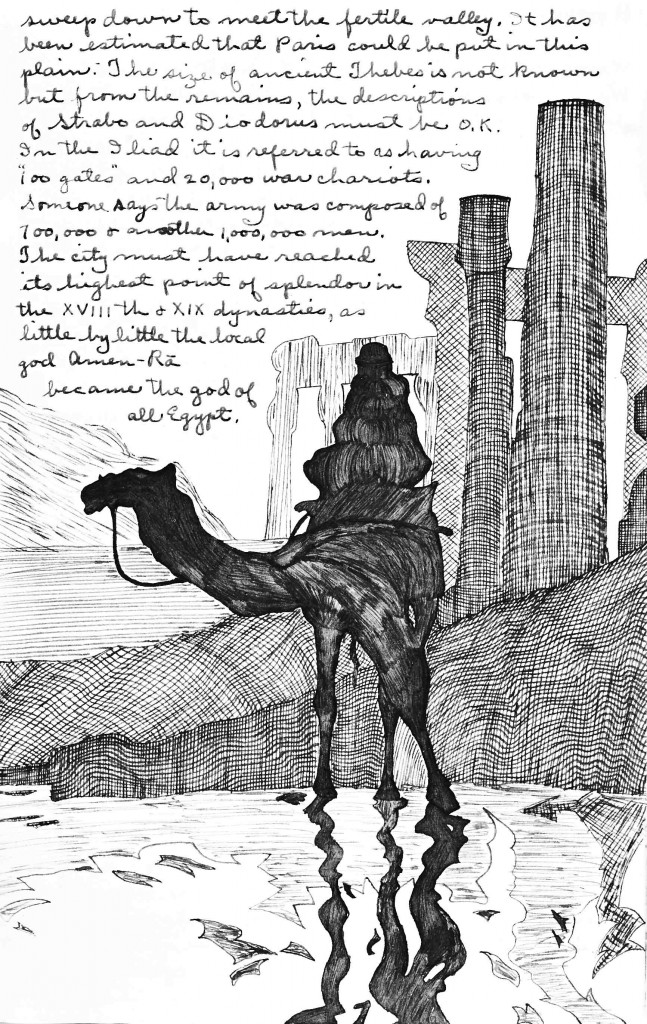
“The Temple of Luxor stands on the river bank in the center of Luxor of today. The city is 450 miles south from Cairo on the east bank of the river and owes its importance as one of the leading winter resorts in the world to its position on the site of ancient Thebes and to Mr. J.M. Cook, the late, who has made it a tourist center. Luxor is a corruption of the Arabic name Al Uksur, which means “the palaces.” Until 1886 the place was but a small mud village, dirty and ill-kept. The American Mission has a Boarding School for Girls here.”
[Lifted and paraphrased from the two guide books:] Ancient Thebes stood on both sides of the Nile and was generally called in hieroglyphics xx, Uast; that part of the city which was situated on the east bank of the river and included Karnac and Luxor appears to have been called xxxx, Apet or ‘throne city’, whence the Coptic zzz and the name Thebes have been derived. It is not known who founded Thebes. Some say it is the most ancient city of Egypt, others that, like Memphis, it was founded by Menes, and others that it was a colony from Memphis. Excavations by Mr. Geo. Legrain prove that the Temple of Karnac of the XVIIIth dynasties stood upon the ruins of one of the XIth, and this in turn upon one of the second, or about 4133 B.C. Thebes stood on a broad plain several miles in extent on both sides of the river. Back from the river the rocky mountains sweep down to meet the fertile valley. It has been estimated that Paris could be put in this plain. The size of ancient Thebes is not known, but from the remains, the descriptions of Strabo and Diodorus must be OK. In the Iliad it is referred to as having ‘100 gates and 20,000 war chariots.’ Someone says the army was composed of 700,000 and another, 1,000,000 men. The city must have reached its highest point of splendor in the XVIIIth and XIXth dynasties, as little by little the local god Amen-Ra became the god of all Egypt.
 Homer writes:
Homer writes:
Nor Thebes so much renown’d/Whose courts with unexhausted wealth abound/Where through a hundred gates with marble arch/To battle twenty thousand chariots march.
Compared with Karnac, the Temple of Luxor is not of the greatest importance and until recently has been buried under piles of rubbish on which native houses stood. In 1883 the excavating was begun and finished about 1888. It is built of sandstone and is dedicated to the Theban triad of Amen-Ra, Mut, and Khonsu, and was called the House of Amen in the Northern Apt, i.e., Karnac. It was built about 1450 B.C. by Amenophis III, and was at that time the most beautiful temple in Egypt, nearly 500 feet long, 180 feet wide, and was connected with Karnac by a paved way on each side of which was a row of ram-headed sphinxes, about a mile in length. Mut was the wife of Amenophis III and Khunsu, the sun god, his son.
The temple has been added to by later kings and during the rule of the Persians over Egypt it was sacked and burnt. The damage was partly made good by the Ptolmeys, but in 27 B.C. it was greatly damaged by an earthquake. Then the Christians converted it into a church and disfigured walls and smashed statues. When these latter could afford to build a church of their own, they forsook the temple and natives built their mud huts in the courts. As these fell down, others were built over them till the temple was filled.
A fine obelisk 82 feet high stands before the pylon of the temple. Its mate now adorns the Place de la Concorde at Paris. The front of the temple was ornamented with six colossal statues of Ramses II, four standing and two seated. Three of the former have been destroyed. The pylon was 80 ft. high and 100 ft in width, with hollow towers. Flags were flown from here in festival times. The face is covered with scriptures and texts which refer to the dedication of the pylon to Amen-Ra and to the victory of Ramses I over his enemies.
The Court of Ramses II is an impressive place, 187 by 157, and surrounded by a double row of papyrus columns with lotus capitals, all inscribed. The colonnade leading to it from the pylon consists of 14 lots columns, massive and beautifully proportioned, 51 ft high and 11 ft thick. There are numerous other smaller courts, chapels, etc.
From the river it is a striking scene and to watch the sun set from its courts is an experience. It never rains here and the sky is always a pure turquoise blue with never a cloud. As the sun drops slowly down toward the rugged mountains across the river and the broad fertile plain, it tinges the surrounding sky a pale orange. The sun is a huge golden ball, and slips down behind the mountains leaving the blue-gray of dusk slowly encroaching upon the fading orange, as mauve night settles over the valley. No array of rainbow colors in this sunset, just a small patch of pale orange sky and that golden ball burning its way down toward the horizon. I could rave on for hours about it. The gently flowing river darkens, reflecting an uncertain image of a sailboat upon the smooth surface.
 Karnac has probably been “holy ground” from the earliest times, and the kings have always lavished much wealth to increase its splendor. The temples of Luxor and Karnac were connected by an avenue about 6,500 feet long and 80 wide, on each side of which was arranged a row of sphinxes. At the end of this avenue to the right is a road which leads to the Temple of Mut, which was also approached by an avenue of sphinxes. Ruins of four temples stand here. From the main avenue again, a smaller one ornamented with ram-headed sphinxes leads to a splendid pylon built by Ptolemy IX, Eurgetes II. Passing through the door, a small avenue of sphinxes leads to a temple built by Ramses III, dedicated to Khonsu, and appears to be built upon the site of an earlier temple of the time of Amenophis III. To the west is still another small temple.
Karnac has probably been “holy ground” from the earliest times, and the kings have always lavished much wealth to increase its splendor. The temples of Luxor and Karnac were connected by an avenue about 6,500 feet long and 80 wide, on each side of which was arranged a row of sphinxes. At the end of this avenue to the right is a road which leads to the Temple of Mut, which was also approached by an avenue of sphinxes. Ruins of four temples stand here. From the main avenue again, a smaller one ornamented with ram-headed sphinxes leads to a splendid pylon built by Ptolemy IX, Eurgetes II. Passing through the door, a small avenue of sphinxes leads to a temple built by Ramses III, dedicated to Khonsu, and appears to be built upon the site of an earlier temple of the time of Amenophis III. To the west is still another small temple.
The great Temple of Amen fronted the Nile and was approached by means of a small avenue of sphinxes, ram-headed, placed there by Ramses II. Excavation work was begun in 1895 on Amen or Amûn by Legrain. This avenue has at the end a quai by which the river once flowed but is now 300 yards away. The first pylon is 370 feet wide, 142½ high, and 49 ft. thick! It was begun in the Ptolemaic Period and left unfinished. The Great Court is 338 by 275. At one side is the Temple of Ramses III. The second great pylon was built by Ramses I and is all  carved and inscribed. This leads to one of the most wonderful buildings in the world, the Hall of Columns or the Great Hypostyle Hall. Twelve columns forming a double row in the center are 60 ft high and about 35 ft in circumference; 122 more are 40 ft high and 27 around. They are arranged in 16 rows. Ramses I set up one column, Seti I 79, and Ramses II the remaining 54. The third propylon is in ruins. Then comes an obelisk 75½ ft. high standing on a base 6 ft square. Inscriptions on the eastern side read “Horus, Mighty Bull, Beloved of Truth, the King of Upper and Lower Egypt, Favorite of the Two Mistresses, Resplendent in the Uraeus Serpent Diadem; Great in Strength Akherperkara-sotepenra. The Golden Horus, Beautiful of Years, making hearts to live, the Son of Ra of his body, Thutmost—Resplendent in Beauty! He made it as his monument for his father Amen, the Lord of Thebes and Guardian of Karnac, so that he might be given life unto Ra forever.”
carved and inscribed. This leads to one of the most wonderful buildings in the world, the Hall of Columns or the Great Hypostyle Hall. Twelve columns forming a double row in the center are 60 ft high and about 35 ft in circumference; 122 more are 40 ft high and 27 around. They are arranged in 16 rows. Ramses I set up one column, Seti I 79, and Ramses II the remaining 54. The third propylon is in ruins. Then comes an obelisk 75½ ft. high standing on a base 6 ft square. Inscriptions on the eastern side read “Horus, Mighty Bull, Beloved of Truth, the King of Upper and Lower Egypt, Favorite of the Two Mistresses, Resplendent in the Uraeus Serpent Diadem; Great in Strength Akherperkara-sotepenra. The Golden Horus, Beautiful of Years, making hearts to live, the Son of Ra of his body, Thutmost—Resplendent in Beauty! He made it as his monument for his father Amen, the Lord of Thebes and Guardian of Karnac, so that he might be given life unto Ra forever.”
Pylons 4, 5, and 6 are all in ruins now. Between 4 and 5 stood 14 large columns with statues, colossal in size, of Osiris, and two huge obelisks of Queen Hatshepsut, one of which still stands, 98 ft. high. The other was 105 ft high. The tops were covered with gold containing a large portion of silver so they could be seen from a great distance. It is the second-highest obelisk in the world, the one in Rome being first. It reads: “When they see my monument in after years, let them exclaim: ‘This it is that was made by me, and take heed lest ye say I know not, I know not. This was made under my order, this mountain fashioned of gold, by my life and by the love of Ra and by the favor of my father Amen, who has filled my nostrils with life and health, I bear the White Crown and am diamened with the Red Crown (crowns of Upper and Lower Egypt), two gods have united unto me their two spans (of life). I rule over this land like the sun of Isis; I am powerful even as the sun of Nu when the sun reposes in the Morning Boat and remains in the Evening Boat; when he places his mother and the Uraeus goddesses in the Sacred Barge, as long as the sky is fixed and firm which he hath created.
“It shall exist forever like unto the North Star. I shall rest in life Atum, therefore of a truth these are two huge obelisks brightened by my Majesty with gold for the sake of her father Amen, and out of love, in order to perpetuate his name that they might stand erect in the Temple precinct forever and ever.” They are one solid block of granite, without any joint or division in them. “My Majesty began this work in (her) fifteenth year (of reign), the first day of (the month) Mesori, which maketh but seven months since the beginning of it in the mountain” (i.e., Aswan quarries). Then there is a Record Hall, a Festal Hall, and a Great Festal Temple, all in more or less ruins. There are ten pylons in all and numberless temples, shrines, etc. The sacred lake stands nearby. It is called Birket El Mallaha by the natives, or The Salt Pool. On its surface the sacred boats of the gods used to float. Today the natives aver that once every year, at night time, a phantom ship of gold sails across the sacred waters. A sun-baked brick wall encloses all of these ruins and is itself pretty well shot.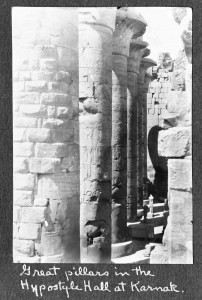
The ancient Egyptians had no one chronological starting point from which to date events. They reckoned time from the accession day of their king. After his death, his successor’s accession day used to serve as a starting point, et cetera. Egyptian history is divided into 30 dynasties.
Thebes was called by the ancient Egyptians Apé or Apiu, the feminine Tapé or Tapiu. The Greeks called it Thebes, after their Thebai. The first Theban king was Antef who was succeeded by public-minded kings who made improvements in and around the little village. Egypt, under the last of the Herakleopolis, was seething with trouble. Some Theban nobles, by a night attack, tried to kill Amenemhat, who was forced to take up arms and thus fought his way to the throne of Egypt. He was kind and helped the poor. He is the founder of the XIIth dynasty under which art and literature flourished; pyramids and giant edifices were built.
During the 13th, 14th, 15th, and 16th dynasties (1788–1580 B.C.) Egypt’s prosperity declined. Some Syrian tribes, the Hyksos or Shepard Kings, discovering its weakness and using a new formidable engine of war, the chariot, occupied the delta and maintained the kings of Thebes as vassals. Intoxicated by success, they smashed the idols and temples, but later identifying Set, the Egyptian God of Evil, with one of their chief deities, reconciled themselves with their subjects and treated them kindly. Despite this, the Egyptians rose up and drove the Hyksos out of Egypt. These former, in order to put an end to claims on the throne by rival families, introduced a novel system of marrying brothers and sisters, and in case of failure of royal issue by queen consort, the royal son of one of the ladies attendant on the deceased king, had to succeed and his authority strengthened by marrying one of the hereditary princesses.
Queen Hatsu or Kemare-Hatsheput, whose name means The First of the Court Ladies, had great personality. She reigned from 1540 to 1515 B.C. and built the beautiful pink temple of Deir el-Bahari in commemoration of an expedition to Punt. But a cruel king later reigned, Amenhotep or Amenophis II. He warred continually and extended the kingdom greatly. Amenophis III, also of the same dynasty, was a great builder and erected the Temple of Luxor, later added to by Ramses II; also the Colossi.
Amemophis IV was a consumptive king and reigned only a short time. But he conceived of the One God, an almighty, powerful god represented in the sun’s disk. He made this the religion of the state and devoted his time to spreading his religion, thus his possessions shrunk. He soon died as did the eldest daughter who succeeded him. Thus the throne fell to the second daughter, Ankh-sen-Aton, and her husband Tut-Ankh-Aton, about 1345 B.C.
 Tut-Ankh-Aton means The Living Image of Aton or the sun. He moved the capital back to Thebes and discarded the worship of Aton for that of Amon as of old. He changed his name to Tut-Ankh-Amen or The Living Image of Amen. Under his rule the Egyptians were contented.
Tut-Ankh-Aton means The Living Image of Aton or the sun. He moved the capital back to Thebes and discarded the worship of Aton for that of Amon as of old. He changed his name to Tut-Ankh-Amen or The Living Image of Amen. Under his rule the Egyptians were contented.
Horem-Heb founded the 18th dynasty, about 1350 to 1315 B.C. Sethos or Seti I was a big fighter and warred against the Libyans and the Syrians. Ramses I preceded him and Ramses II followed. This latter reigned 67 years, the greatest of all Egyptian kings. He built temples at Abu-Simbel, Karnac, Luxor, Ramesseum, Memphis, and others. He also warred extensively against the Hittites. His mummified body is in the Cairo museum.
Here, Egypt’s history becomes a series of wars. Ethiopians, Abyssinians, and Persians invaded Egypt for a while, and were expelled one by one. Alexander the Great took Egypt in 332 B.C. and founded Alexandria which because the center of Greek culture and world commerce. As a result of his death, Ptolemy I Soter I was crowned in 305 B.C. By 205 B.D. the Ptolemaic power began to totter and Thebes was ruled for 19 years by native pharaohs and was afterward deserted in 88 B.C. In 41 B.C. the fatal love story of Antony and Cleopatra. In 31 B.C., Octavianux marched against Antony and defeated him at Actium and took Alexandria. Antony committed suicide and Cleo allowed an asp to bite her. Thus Egypt became a Roman province.
Under Byzantium, Egypt fell to the Eastern Empire in 395 A.D. In 640 A.D. a Moslem army of Caliph Omar’s entered Egypt and took Alexandria, destroying the great library because [its contents] didn’t agree with the Koran. This the creme of the world’s learning was used as fuel for [their] 4,000 baths.
Quarrels between sultans, caliphs, kings, and emirs followed till Sultan Selim I of Turkey ruled her in 1517 and soon after the Battle of the Nile, in 1798, Napoleon Bonaparte occupied the country. In 1805, Mohammed Ali Pasha, a young soldier of fortune from Cavala, Macedonia, made an appearance here and put an end to all troubles of the corrupt Mameluke princes’ government. He was a great builder and made many improvements as did his grandson, Ismail Pasha, who built railroads and encouraged the Suez Canal construction. The present ruler, H.M. King Fuad I, is his son.
 Three hours of wandering about through the cool courts in the shade of mammoth columns and pylons, and then I returned to my 10-piastre hotel, hot, tired from no sleep hardly for nearly 60 hours (4 hrs. sleep) and plenty dusty and dirty. From the verandah on the second floor I watched the marvelous sunset over the palms and behind the misty Egyptian Rockies. Then I fell asleep over a guide book of Egypt.
Three hours of wandering about through the cool courts in the shade of mammoth columns and pylons, and then I returned to my 10-piastre hotel, hot, tired from no sleep hardly for nearly 60 hours (4 hrs. sleep) and plenty dusty and dirty. From the verandah on the second floor I watched the marvelous sunset over the palms and behind the misty Egyptian Rockies. Then I fell asleep over a guide book of Egypt.
 Today I visited the Mount of Olives. I followed the road past the post office and just outside the city walls. Passed the Damascus Gate, the most beautiful gate in Jerusalem, and of the 16th century. Continuing down the hill I came to Gethsemane, once a garden or grove belonging to the family of Jesus. St. John tells us that Jesus often came there with his disciples to worship and pray, and Mary is buried there. Nearby is a grotto which Jesus used to retire with his disciples for prayer, food, and rest. It was to here that he brought back his apostles after the last supper. To the right, as I turned up the steep stony path to the top of the Mount, was the Third Church of the Agony of Our Lord, built in 1922 of graceful and ornate lines. Farther up the hill and more to the south is the Russian Church of St. Mary Magdalene, built in 1888 by the Emperor Alexander III. It is just above the Rock of Apostles, where Jesus said to Peter, James, and John, “My soul is sorrowful unto death; wait here and watch with me.” He went a stone’s throw farther, fell upon his face upon the ground, and bathed the earth with a sweat of blood. The church is of Russian design, with seven cupolas, gilded and very picturesque.
Today I visited the Mount of Olives. I followed the road past the post office and just outside the city walls. Passed the Damascus Gate, the most beautiful gate in Jerusalem, and of the 16th century. Continuing down the hill I came to Gethsemane, once a garden or grove belonging to the family of Jesus. St. John tells us that Jesus often came there with his disciples to worship and pray, and Mary is buried there. Nearby is a grotto which Jesus used to retire with his disciples for prayer, food, and rest. It was to here that he brought back his apostles after the last supper. To the right, as I turned up the steep stony path to the top of the Mount, was the Third Church of the Agony of Our Lord, built in 1922 of graceful and ornate lines. Farther up the hill and more to the south is the Russian Church of St. Mary Magdalene, built in 1888 by the Emperor Alexander III. It is just above the Rock of Apostles, where Jesus said to Peter, James, and John, “My soul is sorrowful unto death; wait here and watch with me.” He went a stone’s throw farther, fell upon his face upon the ground, and bathed the earth with a sweat of blood. The church is of Russian design, with seven cupolas, gilded and very picturesque.

 the right is the marble tomb covering the rocky tomb in which he was laid. This tomb has a long history and has several times been opened. Several hundred years ago when it was opened, a piece of wood, probably part of the cross, was found wrapped in a piece of worn cloth. A large crack was made on purpose in this marble slab over the top. Pilgrims kiss this slab, a monk attends in the chamber, and also keeps the candles burning by the tomb. There are numerous other places and altars in the church, each belonging to one of the five Christian sects: Greek Orthodox, Armenians, Latins, Copts, and Greek. These mark spots where the cross was found down in a grotto where Christ and the two thieves were put on the cross, etc.
the right is the marble tomb covering the rocky tomb in which he was laid. This tomb has a long history and has several times been opened. Several hundred years ago when it was opened, a piece of wood, probably part of the cross, was found wrapped in a piece of worn cloth. A large crack was made on purpose in this marble slab over the top. Pilgrims kiss this slab, a monk attends in the chamber, and also keeps the candles burning by the tomb. There are numerous other places and altars in the church, each belonging to one of the five Christian sects: Greek Orthodox, Armenians, Latins, Copts, and Greek. These mark spots where the cross was found down in a grotto where Christ and the two thieves were put on the cross, etc.
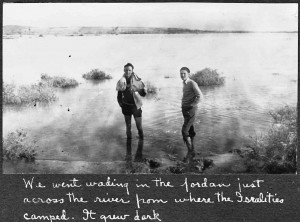 Walking out through the big desert or plain toward the
Walking out through the big desert or plain toward the 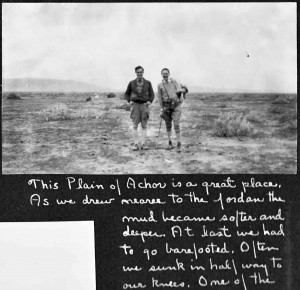 Gilead and Moab were turned a red. We stumbled on in the mud and dark, hoping it would not be necessary to cross the stream. The moon was only a quarter, but the rest was plainly visible. Millions of stars shone brightly overhead. By following the stream up to the main road we didn’t have to wade across again. No sooner had we reached the road than a truck came along and Frank hailed it. Thus we got a ride to Jerusalem. Otherwise we might have had to spend the night in Jericho, a small town of 1,000 and lots of mud and dirt. Had a grand concert on the way back and after dinner, arrived at the hotel at 9 PM. We passed Bethany on the way a short distance from Jerusalem. It is but a tiny village along the road. The trip back cost two bob apiece.
Gilead and Moab were turned a red. We stumbled on in the mud and dark, hoping it would not be necessary to cross the stream. The moon was only a quarter, but the rest was plainly visible. Millions of stars shone brightly overhead. By following the stream up to the main road we didn’t have to wade across again. No sooner had we reached the road than a truck came along and Frank hailed it. Thus we got a ride to Jerusalem. Otherwise we might have had to spend the night in Jericho, a small town of 1,000 and lots of mud and dirt. Had a grand concert on the way back and after dinner, arrived at the hotel at 9 PM. We passed Bethany on the way a short distance from Jerusalem. It is but a tiny village along the road. The trip back cost two bob apiece. Tuesday, February 12, 1929
Tuesday, February 12, 1929
 The usual mob of hotel agents descended in the Port Said station. We rode in the bus to the Continental free, where we got our rooms for 40 piastres for all. I have less than 25 suds to last me this month and had better not go to Luxor after all but hold down the Port till the boys come home. I’ll get the dope on prices tomorrow but not much hope as I have to be financially OK for India.
The usual mob of hotel agents descended in the Port Said station. We rode in the bus to the Continental free, where we got our rooms for 40 piastres for all. I have less than 25 suds to last me this month and had better not go to Luxor after all but hold down the Port till the boys come home. I’ll get the dope on prices tomorrow but not much hope as I have to be financially OK for India. Thursday, February 14, 1929
Thursday, February 14, 1929

 If ignorance is bliss, I wonder just what lowly place dumbness holds down in the category. Wherever that be, you’ll find me, 99-44/100% pure dumb. The other 56/100% happened to recall that I crossed the Atlantic at three cinders a day. This most remarkable thought, to which I was very kind, made me shake off the hay earlier than I have been guilty of, of late. Taking the letters sent me by the U.S. Shipping Board, I set out to hunt down the agents of one of the Shipping Board lines. The most potent paper I had was an authorization to any agent to give me return passage to the States at the $3-a-day rate. Although Mr. McAndrews in London understood I might go on around, I had no written words to that effect. After chasing from one end of the town to the other a couple of times, I tracked down the victims in the form of the British Coaling Co. It didn’t take long to convince them that I should get passage to India at the same rate along with Mort and Frank, this saving some $15 or $20 apiece for us, to say nothing of raising us from deck passengers to first class. At the present time I am busily engaged in kicking myself all over Lower Egypt for being so dumb in Gib and losing 35 or 40 dollars by it.
If ignorance is bliss, I wonder just what lowly place dumbness holds down in the category. Wherever that be, you’ll find me, 99-44/100% pure dumb. The other 56/100% happened to recall that I crossed the Atlantic at three cinders a day. This most remarkable thought, to which I was very kind, made me shake off the hay earlier than I have been guilty of, of late. Taking the letters sent me by the U.S. Shipping Board, I set out to hunt down the agents of one of the Shipping Board lines. The most potent paper I had was an authorization to any agent to give me return passage to the States at the $3-a-day rate. Although Mr. McAndrews in London understood I might go on around, I had no written words to that effect. After chasing from one end of the town to the other a couple of times, I tracked down the victims in the form of the British Coaling Co. It didn’t take long to convince them that I should get passage to India at the same rate along with Mort and Frank, this saving some $15 or $20 apiece for us, to say nothing of raising us from deck passengers to first class. At the present time I am busily engaged in kicking myself all over Lower Egypt for being so dumb in Gib and losing 35 or 40 dollars by it.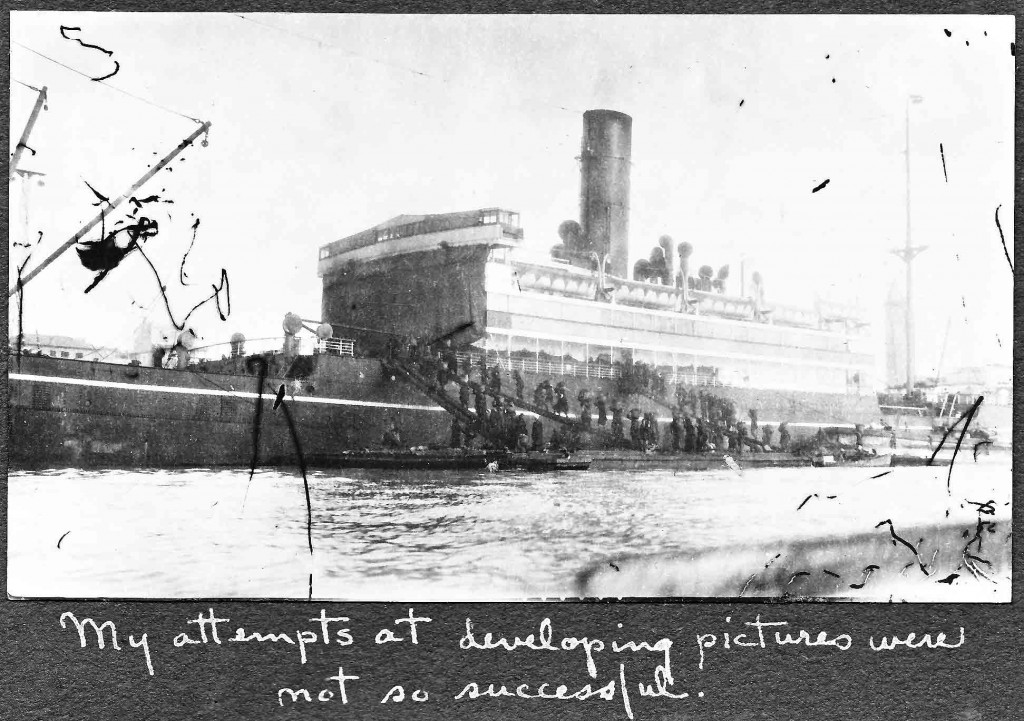 Panama Canal!
Panama Canal! Wednesday, February 20, 1929
Wednesday, February 20, 1929


 The
The 

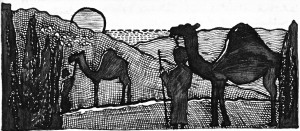
 The P&O
The P&O  Wednesday, March 6, 1929
Wednesday, March 6, 1929

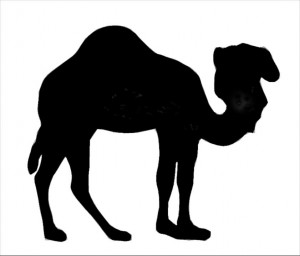 From Port Said to El Kantara the RR, road, and a small canal and the Suez Canal skirt the eastern shore of
From Port Said to El Kantara the RR, road, and a small canal and the Suez Canal skirt the eastern shore of 



 Flies and fleas
Flies and fleas
 Homer writes:
Homer writes: Karnac
Karnac  carved and inscribed. This leads to one of the most wonderful buildings in the world, the Hall of Columns or the Great Hypostyle Hall. Twelve columns forming a double row in the center are 60 ft high and about 35 ft in circumference; 122 more are 40 ft high and 27 around. They are arranged in 16 rows. Ramses I set up one column, Seti I 79, and Ramses II the remaining 54. The third propylon is in ruins. Then comes an obelisk 75½ ft. high standing on a base 6 ft square. Inscriptions on the eastern side read “Horus, Mighty Bull, Beloved of Truth, the King of Upper and Lower Egypt, Favorite of the Two Mistresses, Resplendent in the Uraeus Serpent Diadem; Great in Strength Akherperkara-sotepenra. The Golden Horus, Beautiful of Years, making hearts to live, the Son of Ra of his body, Thutmost—Resplendent in Beauty! He made it as his monument for his father Amen, the Lord of Thebes and Guardian of Karnac, so that he might be given life unto Ra forever.”
carved and inscribed. This leads to one of the most wonderful buildings in the world, the Hall of Columns or the Great Hypostyle Hall. Twelve columns forming a double row in the center are 60 ft high and about 35 ft in circumference; 122 more are 40 ft high and 27 around. They are arranged in 16 rows. Ramses I set up one column, Seti I 79, and Ramses II the remaining 54. The third propylon is in ruins. Then comes an obelisk 75½ ft. high standing on a base 6 ft square. Inscriptions on the eastern side read “Horus, Mighty Bull, Beloved of Truth, the King of Upper and Lower Egypt, Favorite of the Two Mistresses, Resplendent in the Uraeus Serpent Diadem; Great in Strength Akherperkara-sotepenra. The Golden Horus, Beautiful of Years, making hearts to live, the Son of Ra of his body, Thutmost—Resplendent in Beauty! He made it as his monument for his father Amen, the Lord of Thebes and Guardian of Karnac, so that he might be given life unto Ra forever.”
 Tut-Ankh-Aton means The Living Image of Aton or the sun. He moved the capital back to Thebes and discarded the worship of Aton for that of Amon as of old. He changed his name to Tut-Ankh-Amen or The Living Image of Amen. Under his rule the Egyptians were contented.
Tut-Ankh-Aton means The Living Image of Aton or the sun. He moved the capital back to Thebes and discarded the worship of Aton for that of Amon as of old. He changed his name to Tut-Ankh-Amen or The Living Image of Amen. Under his rule the Egyptians were contented. Three hours of wandering about through the cool courts in the shade of mammoth columns and pylons, and then I returned to my 10-piastre hotel, hot, tired from no sleep hardly for nearly 60 hours (4 hrs. sleep) and plenty dusty and dirty. From the verandah on the second floor I watched the marvelous sunset over the palms and behind the misty Egyptian Rockies. Then I fell asleep over a guide book of Egypt.
Three hours of wandering about through the cool courts in the shade of mammoth columns and pylons, and then I returned to my 10-piastre hotel, hot, tired from no sleep hardly for nearly 60 hours (4 hrs. sleep) and plenty dusty and dirty. From the verandah on the second floor I watched the marvelous sunset over the palms and behind the misty Egyptian Rockies. Then I fell asleep over a guide book of Egypt.
 more. They represent him seated on his throne with his mother and wife on either side and an unrecognized small statue between his legs. Each was originally of one block of stone, difficult to work because of its hardness. The southern statue is 65 feet high. The missing legs measures 19½ feet from sole to knee, each foot 10 feet, shoulders 20 ft. broad each, arm from tip of finger to elbow 15½ ft. About 27 B.C. the northern one was broken in two by an earthquake. Since then it has been called the
more. They represent him seated on his throne with his mother and wife on either side and an unrecognized small statue between his legs. Each was originally of one block of stone, difficult to work because of its hardness. The southern statue is 65 feet high. The missing legs measures 19½ feet from sole to knee, each foot 10 feet, shoulders 20 ft. broad each, arm from tip of finger to elbow 15½ ft. About 27 B.C. the northern one was broken in two by an earthquake. Since then it has been called the  From this hill I had an excellent view of the famous Temple of
From this hill I had an excellent view of the famous Temple of 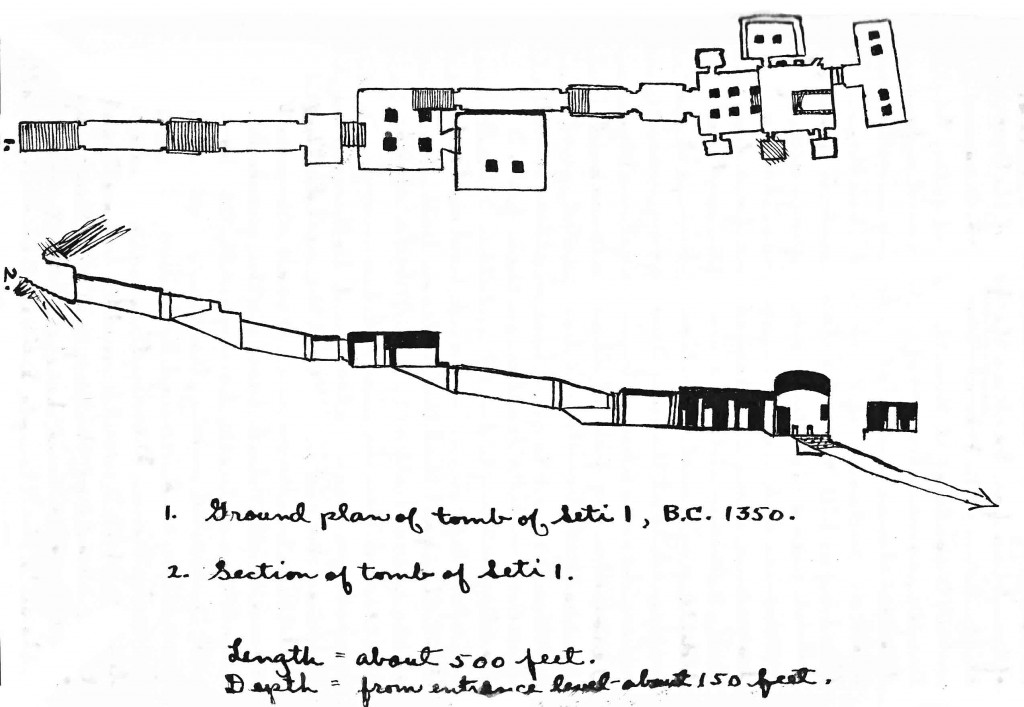 The mummy was found at Dêr al-Baharî in 1904 (?) when it was hidden by the priests in some time of disturbance. The beautiful sarcophagus is in London. Paintings and inscriptions cover the walls and roof, of mythological and religious scenes, which refer to the passage of the sun, and of the king also, through the Underworld. On the sloping sections of the walls is a copy of the “Book of the Praisings of Ra” and on those of the chambers, 11 of the 12 sections of the “Book of That Which is in the Underworld.” For some extraordinary reason the 12th is omitted. The tomb was evidently not finished at the time of the king’s death for some of the figures of gods, etc. are only traced in outline and the scribe was stopped so suddenly in his work that he even left the section he was doing unfinished.
The mummy was found at Dêr al-Baharî in 1904 (?) when it was hidden by the priests in some time of disturbance. The beautiful sarcophagus is in London. Paintings and inscriptions cover the walls and roof, of mythological and religious scenes, which refer to the passage of the sun, and of the king also, through the Underworld. On the sloping sections of the walls is a copy of the “Book of the Praisings of Ra” and on those of the chambers, 11 of the 12 sections of the “Book of That Which is in the Underworld.” For some extraordinary reason the 12th is omitted. The tomb was evidently not finished at the time of the king’s death for some of the figures of gods, etc. are only traced in outline and the scribe was stopped so suddenly in his work that he even left the section he was doing unfinished. The inscriptions on these tombs were written to effect this object and may be grouped into three divisions:
The inscriptions on these tombs were written to effect this object and may be grouped into three divisions: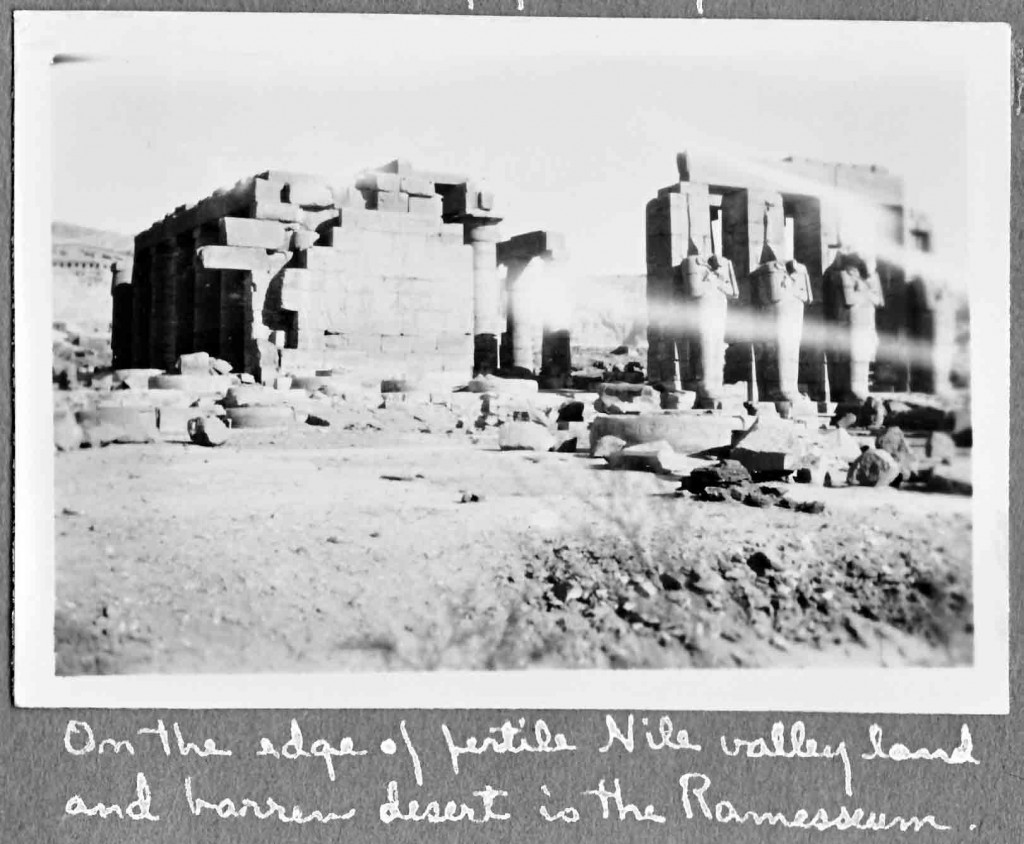
 I was now on the same hill I had been on the preceding day. It is actually lousy with tombs, and I visited many, though they are nearly all the same and roughly hewn, without inscriptions. Descending to the plain level, I thought I would melt before I got to the shade of the temple of Menthu-hetup III. I spent some time here at that wild Hatasu’s pink temple Deir el-Bahari. Finally an overgrown bee became too friendly, so I left. Tourists were pretty scarce. Most usually come in the morning or later on in the afternoon, spending the hot hours sipping cool drinks of water (?) in the shade of the Winter Palace’s nice verandah overlooking the Nile. I seem to be the only person in Luxor who has a financial status so flat that even walking is a luxury because of the wear and tear on shoe leather. At least I am the only one that will admit the fact.
I was now on the same hill I had been on the preceding day. It is actually lousy with tombs, and I visited many, though they are nearly all the same and roughly hewn, without inscriptions. Descending to the plain level, I thought I would melt before I got to the shade of the temple of Menthu-hetup III. I spent some time here at that wild Hatasu’s pink temple Deir el-Bahari. Finally an overgrown bee became too friendly, so I left. Tourists were pretty scarce. Most usually come in the morning or later on in the afternoon, spending the hot hours sipping cool drinks of water (?) in the shade of the Winter Palace’s nice verandah overlooking the Nile. I seem to be the only person in Luxor who has a financial status so flat that even walking is a luxury because of the wear and tear on shoe leather. At least I am the only one that will admit the fact.


 In due time we arrived at Assint, a good-sized town on the Nile’s bank. A mile back from the city is the same range of rocky hills that in Luxor are called the Theban Hills. For centuries and centuries these hills by Assint have been used as a burial place for the dead. The steep slopes are honeycombed with small holes dug into the rock in which the mummified body of the person was placed. Many tombs consisted of one or more small chambers hewn of the rock. A few were very large, having the appearance of a cave, and I saw less than half a dozen with inscriptions. At some early date all of these tombs have been robbed and the mummies scattered about. Large vultures circle low over the hills as if in search of mummified meat. Bleached bones and parts of bodies are everywhere on the ground,
In due time we arrived at Assint, a good-sized town on the Nile’s bank. A mile back from the city is the same range of rocky hills that in Luxor are called the Theban Hills. For centuries and centuries these hills by Assint have been used as a burial place for the dead. The steep slopes are honeycombed with small holes dug into the rock in which the mummified body of the person was placed. Many tombs consisted of one or more small chambers hewn of the rock. A few were very large, having the appearance of a cave, and I saw less than half a dozen with inscriptions. At some early date all of these tombs have been robbed and the mummies scattered about. Large vultures circle low over the hills as if in search of mummified meat. Bleached bones and parts of bodies are everywhere on the ground,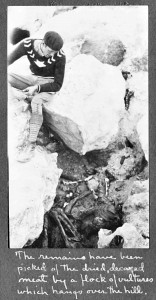 and crunch under your foot. Great piles and hills of bones bleach under a hot sun. I have seen plenty of mummies and in all states of decomposition, etc., but it has never affected me as this morbid scene did. Cold chills were continually running up and down my back. While walking among the hills I saw a fox walking up through a stony ravine sporting a fine bushy tail. Just around the corner of the hill is what appears to be a large city of small houses, walled in, and domes. It stretches far out over the sand along the border of the fertile tract. This is a Moslem graveyard. When the warm sun began to drop down toward a rim of sand, I wended my way back to Assint, this time through the native bazaar where tin-makers and other craftsmen worked at their trades while languid curious persons puffed lazily at water pipes. My luggage was parked at the Grand Hotel, where I returned to write a letter. The establishment more nearly resembles a gambling joint where the male population of the city play furiously at dominoes.
and crunch under your foot. Great piles and hills of bones bleach under a hot sun. I have seen plenty of mummies and in all states of decomposition, etc., but it has never affected me as this morbid scene did. Cold chills were continually running up and down my back. While walking among the hills I saw a fox walking up through a stony ravine sporting a fine bushy tail. Just around the corner of the hill is what appears to be a large city of small houses, walled in, and domes. It stretches far out over the sand along the border of the fertile tract. This is a Moslem graveyard. When the warm sun began to drop down toward a rim of sand, I wended my way back to Assint, this time through the native bazaar where tin-makers and other craftsmen worked at their trades while languid curious persons puffed lazily at water pipes. My luggage was parked at the Grand Hotel, where I returned to write a letter. The establishment more nearly resembles a gambling joint where the male population of the city play furiously at dominoes.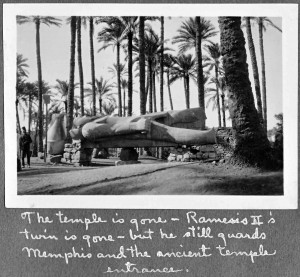 Memphis brought out nothing new except a giant status of Ramses II, 42 feet long and laying in a mud hut, which I missed on the first trip. When I got to Sakkarah on the edge of the desert, a guide attached himself to the party and refused to leave. Finally I decided to let him have a lesson, so when he demanded piastres near the Step Pyramid, I told him what I thought of him and guides in general. Still he insisted, so I stuffed the camera in my jacket and got down to business. He looked surprised and started to hit me with his staff, but changed his mind and probably cussed and cursed me up and down as I left him standing along on the sandy desert. We must have been a ludicrous sight, arguing and gesticulating way out there in a deserted desert. I seem to have acquired the habit of helping my vocal efforts with my hands.
Memphis brought out nothing new except a giant status of Ramses II, 42 feet long and laying in a mud hut, which I missed on the first trip. When I got to Sakkarah on the edge of the desert, a guide attached himself to the party and refused to leave. Finally I decided to let him have a lesson, so when he demanded piastres near the Step Pyramid, I told him what I thought of him and guides in general. Still he insisted, so I stuffed the camera in my jacket and got down to business. He looked surprised and started to hit me with his staff, but changed his mind and probably cussed and cursed me up and down as I left him standing along on the sandy desert. We must have been a ludicrous sight, arguing and gesticulating way out there in a deserted desert. I seem to have acquired the habit of helping my vocal efforts with my hands.
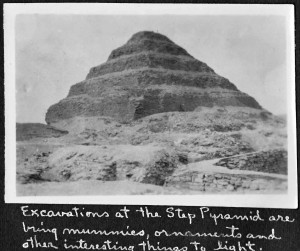

 Ahmad Yousef proved a very entertaining host. He is an artist, poet, author of ten books on art and including one on marriage, and at the time is working for the government in the excavations, restoring ruins of temples, etc. To quote him: “I am the most wonderful artist in Egypt. But since my brother has returned from England where he studied portraits, he is the best portrait painter in Egypt. I have not done that sort of work since 1924 and now it is too hard for my eyes.” Walls covered with paintings and sketches proved that he had ability. And all of this at the age of 25, after 7 years of teaching himself to paint without the aid of school. He showed me many of his works and articles and covers of magazines which he had done. Lunch followed, served by a man who acted as servant. Then we examined his kodak pictures, etc. which are extremely well done. He gave me many showing the life of Egypt and said he would send me more in the future. [
Ahmad Yousef proved a very entertaining host. He is an artist, poet, author of ten books on art and including one on marriage, and at the time is working for the government in the excavations, restoring ruins of temples, etc. To quote him: “I am the most wonderful artist in Egypt. But since my brother has returned from England where he studied portraits, he is the best portrait painter in Egypt. I have not done that sort of work since 1924 and now it is too hard for my eyes.” Walls covered with paintings and sketches proved that he had ability. And all of this at the age of 25, after 7 years of teaching himself to paint without the aid of school. He showed me many of his works and articles and covers of magazines which he had done. Lunch followed, served by a man who acted as servant. Then we examined his kodak pictures, etc. which are extremely well done. He gave me many showing the life of Egypt and said he would send me more in the future. [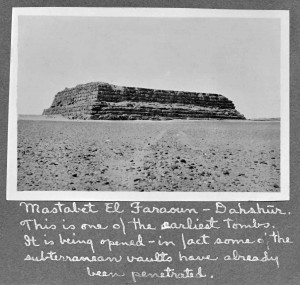



 Our handout from the cook was very good. At nine, Morton strayed off, returning with a huge dipper heaped with
Our handout from the cook was very good. At nine, Morton strayed off, returning with a huge dipper heaped with 

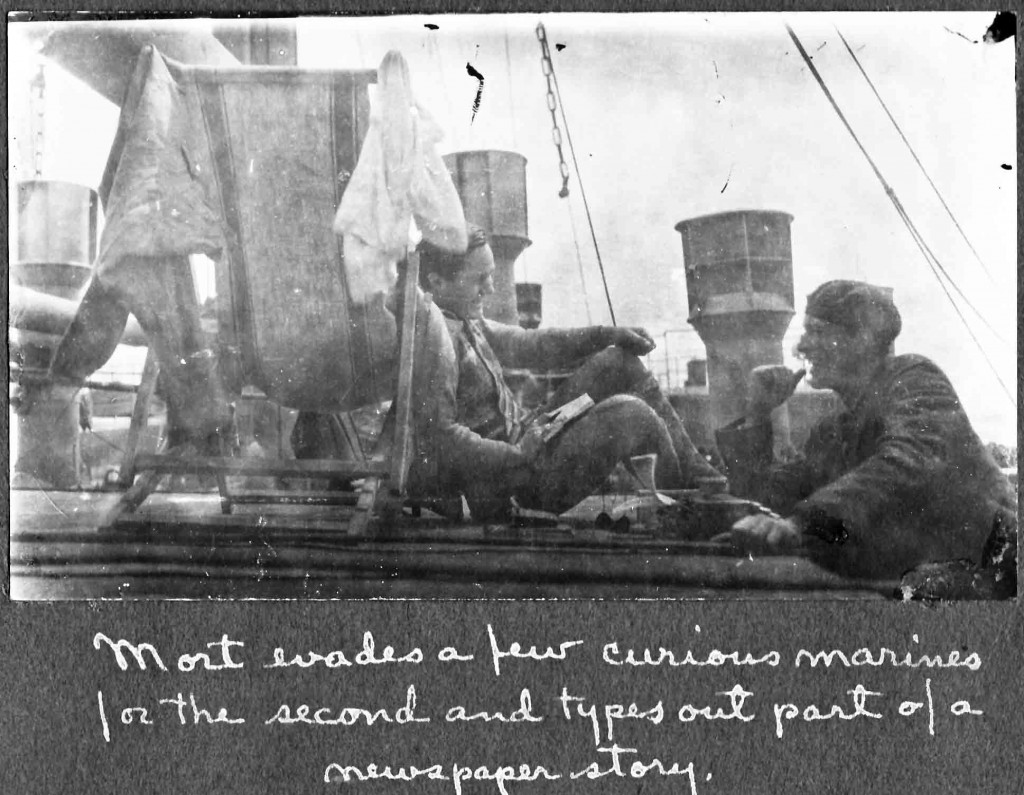
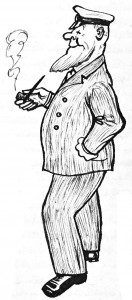
 Thursday Tuesday, March 26, 1929
Thursday Tuesday, March 26, 1929
 I was awakened before six by derricks and men raising cain on our hatch. I saw we were in the harbor at
I was awakened before six by derricks and men raising cain on our hatch. I saw we were in the harbor at  The main drag is along the harbor where darkies push big wagons heavily loaded, singing a chant. I suspect they were suggesting that Mohammed push the cart for them, for those who had mules or horses to work for them sang nothing. This road is lined on its side from the harbor with low brick buildings having the cloistered sidewalks as a protection from the sun. An imposing bank of white plaster reposes in a sort of large square. In front of this a group of children were squatting on the ground
The main drag is along the harbor where darkies push big wagons heavily loaded, singing a chant. I suspect they were suggesting that Mohammed push the cart for them, for those who had mules or horses to work for them sang nothing. This road is lined on its side from the harbor with low brick buildings having the cloistered sidewalks as a protection from the sun. An imposing bank of white plaster reposes in a sort of large square. In front of this a group of children were squatting on the ground 
 Saturday
Saturday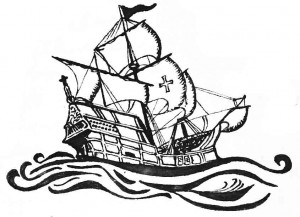

 Tonight there is a show put on by the boys. If the band performs, it will be a riot, for this organization has been tooting of late up forward and, take it from me, they are out of tune. We were talking to one of the star singers today. He surely is a typical sailor. Has been in the navy 6 years. Told us about how the Americans and Italians in Shanghai would fight with the British and French sailors. This particular scrap was a wild one in a cabaret over a Russian girl an Italian was dancing with. It ended after the Yanks had killed two British and the Italians three Frenchmen. He has a girl in every port, but doesn’t care for any of them. An ugly one in China wants to marry him. He is going to do it because she has $100,000 which is what he is after. Then he says he’ll tell her good-bye once he has the money; or if she wants to come to Italy, he will drop her overboard to the sharks in the Red Sea. He is a case, wild, carefree.
Tonight there is a show put on by the boys. If the band performs, it will be a riot, for this organization has been tooting of late up forward and, take it from me, they are out of tune. We were talking to one of the star singers today. He surely is a typical sailor. Has been in the navy 6 years. Told us about how the Americans and Italians in Shanghai would fight with the British and French sailors. This particular scrap was a wild one in a cabaret over a Russian girl an Italian was dancing with. It ended after the Yanks had killed two British and the Italians three Frenchmen. He has a girl in every port, but doesn’t care for any of them. An ugly one in China wants to marry him. He is going to do it because she has $100,000 which is what he is after. Then he says he’ll tell her good-bye once he has the money; or if she wants to come to Italy, he will drop her overboard to the sharks in the Red Sea. He is a case, wild, carefree.


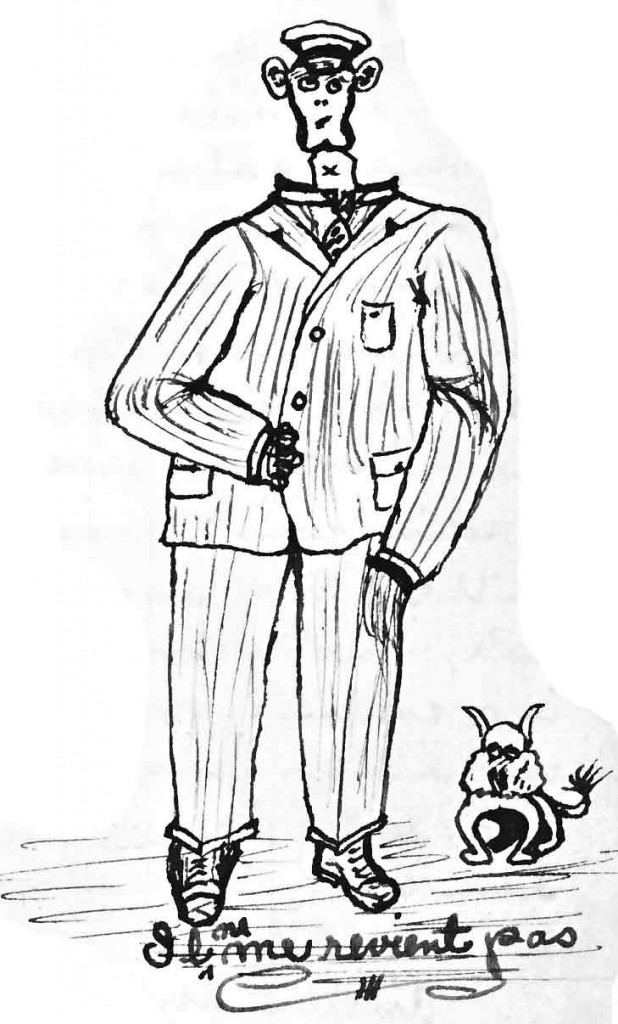
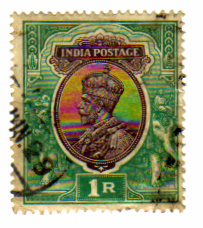 Cranes and whistles spoiled all chances of any sleep after 4 or 5AM. It was dark and I could see the lights of
Cranes and whistles spoiled all chances of any sleep after 4 or 5AM. It was dark and I could see the lights of  After lunch we walk to the cantonment or English section and bought helmets and shorts for Frank and Mort and some other necessities. On the way back we stopped in a restaurant to get our lunch-dinner. M and F had steak and chips for 13¢ per and I mutton and rice @ the same. The water is not so good, so we get lemonade or tea for 3¢ and 2¢. Back to the hotel I developed 4 rolls of films. I was sitting on a bed writing “beds consist” when I saw a huge bed-bug and some children traveling across the cover toward me. Well, after a couple of months of them in Europe, I was fed to say the least. Frank and I had a fit, but Mort hauled out his Unity as a protection. [What is this??] Now everything is itching. Twelve o’clock—only 6 more hours to go. Might as well write all night, maybe take a few hours off in a chair. No rest for the wicked—and I’ve had durned little sleep since March 10. Mort’s Unity seems to be weakening and we are going out to see the night-life of Karachi. Frank is too sleepy and is on the floor knocking it off.
After lunch we walk to the cantonment or English section and bought helmets and shorts for Frank and Mort and some other necessities. On the way back we stopped in a restaurant to get our lunch-dinner. M and F had steak and chips for 13¢ per and I mutton and rice @ the same. The water is not so good, so we get lemonade or tea for 3¢ and 2¢. Back to the hotel I developed 4 rolls of films. I was sitting on a bed writing “beds consist” when I saw a huge bed-bug and some children traveling across the cover toward me. Well, after a couple of months of them in Europe, I was fed to say the least. Frank and I had a fit, but Mort hauled out his Unity as a protection. [What is this??] Now everything is itching. Twelve o’clock—only 6 more hours to go. Might as well write all night, maybe take a few hours off in a chair. No rest for the wicked—and I’ve had durned little sleep since March 10. Mort’s Unity seems to be weakening and we are going out to see the night-life of Karachi. Frank is too sleepy and is on the floor knocking it off.
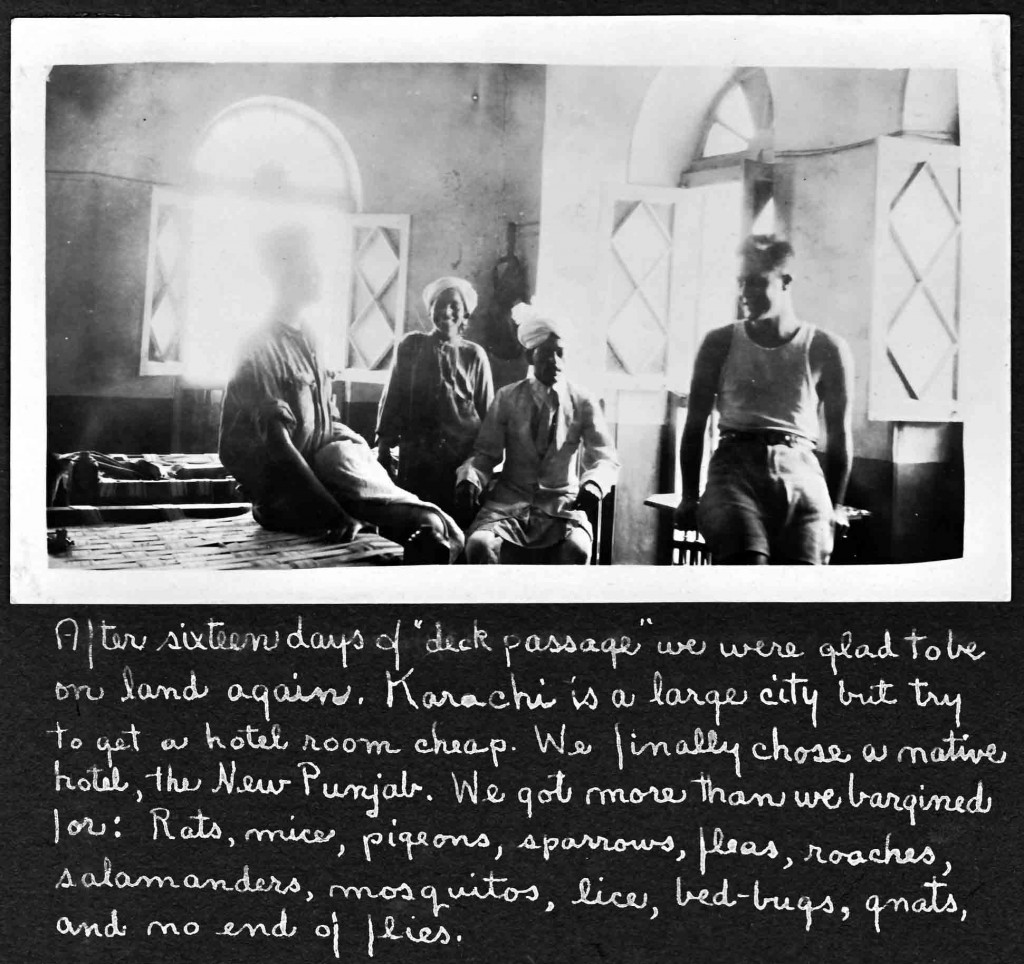
 Mort and I went to market for some food in the evening and wandered down into the souk on the way back. The
Mort and I went to market for some food in the evening and wandered down into the souk on the way back. The 
